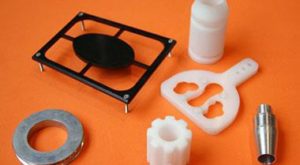Since the mid-1800s, plastic has changed our lives by providing a flexible material that can be used in numerous ways to fashion clothing, containers, parts, tubing and so much more. What began as a single product called Parkesine has evolved into a wide-range of products that fall under the topical name plastic.
The Original Plastic
In 1862, Alexander Parkes invented man-made plastic and presented it to crowds at London’s Great International Exhibition. Derived from the organic material cellulose, he called the invention Parkesine. He showed that you could heat it, mould it and when cooled, it would retain that shape. Parkes’ invention inspired further research into cellulose-derived materials.
The Next Step: Celluloid
John Wesley Hyatt continued the work of plastic materials, developing celluloid by combining cellulose and alcoholized camphor six years later. He used the substance as a substitute for billiard ball ivory. The flexibility of the substance enabled it to take many forms and celluloid was used to create the first flexible photographic film. This brought major developments in the still photography and motion picture industries. Hyatt’s invention created the film movie market that became popular in 1900.
Baking with Plastic
The year following celluloid’s development brought about the invention that led to Bakelite. Bakelite’s invention stemmed from a project to create white chalkboards. Using formaldehyde resins mixed the milk protein casein, researchers developed Galalith and Erinoid. The British issued a patent in 1899 to Arthur Smith for processing a formaldehyde resin, but Leo Hendrik Baekeland improved the invention in 1907, creating the first completely synthetic resin called Bakelite. Bakelite became a popular material for bowls, cups, jewellery, telephones and more. This is because Bakelite retains its form and shape when exposed to heat or stress. Its invention started both a fashion trend in the 1920s and 1930s and a housewares trend. Today, Bakelite jewellery and housewares from the era are consider antiques.
A helpful kitchen item still used today came about in 1912. A Swiss chemist wanting a waterproof tablecloth developed cellophane. It became even more useful when DuPont improved it by making it moisture-resistant in 1927.
In 1933, Dow Chemical developed polyvinylidene chloride as a saltwater protectant for military equipment. You know it better today by its household name – Saran – as in SaranWrap. The intended military invention also clings to almost anything. It forms an oxygen barrier which keeps food safer.
Helping Everyone Look Good
When you think of engineering plastic, you probably think of sheets of Plexiglass, but that was still years in the making when France’s Count of Chardonnet, Louis Marie Hilaire Bernigaut, created one of the plastic materials that would change the face of fashion. In 1889, Bernigaut invented rayon, a silk substitute which made silk stockings much more affordable. Rayon now forms many off the rack clothes.
In 1939, DuPont followed up the French development of rayon with the development of nylon. From it he fashioned the first pair of women’s nylons, also called pantyhose. Unveiling the new women’s fashion invention at New York’s World Fair, DuPont created a fashion innovation that saw nylon replace silk in clothing. The reverse of Saran moving from the military application to the kitchen, nylon moved from fashion to military applications during World War II.
Entertaining Us In Many Ways
In the 1920s, researchers worked on a hardy material that could be both flexible and sturdy. They developed polyvinyl chloride, also referred to as PVC or just vinyl. Today, vinyl forms the blood bags and IV tubing that saves lives in emergency rooms around the world and forms many of the construction materials on our homes like the electrical cable insulation, flooring, piping, roofing and siding. It even forms the tubing and hoses with which we water our lawns. If you listened to music before the .mp3 and CD eras though, you know this little invention best for vinyl records. In 1931, RCA Victor released the first vinyl record. Until that time other substances that weren’t as hearty or as durable had been used as a recording material. Vinyl also provided a cheaper, easier to mass produce material and this revolutionised the music industry.
Housing and Housewares
The 1930s brought two more life changing plastics – polyethylene and acrylic. You probably use polyethylene on a daily basis in your kitchen. It forms our bags, beverage bottles, food storage containers and milk and water jugs.
In 1936, acrylic, scientifically known as polymethyl methacrylate, was invented. Today it goes by numerous trade names including Acrylite, Crylux, Lucite, Perspex and Plexiglas. This glass alternative comes as a transparent thermoplastic in plastic sheets that can also accept coatings or inks, so it comes in numerous colours. Probably what you think of when you think of engineering plastic, it is lighter than glass and shatter-resistant. You’ll find it making up tubs, counter tops and as sheets of Perspex in storm doors.
Today’s Products
The 1950s spawned two developments – polyester and polypropylene. If you’re still thinking of plastic sheets, you should know that you’re probably wearing something right now with one of these 1950s plastics in it. DuPont first discovered polyester in the 1940s but marketed it in the 1950s as the fabric Dacron. Today, polypropylene gets added to almost all plastic applications.
Developed in 1958 by both General Electric and Bayer, Lexan, also known as Merlon, is cross-licensed. Lexan has a unique chemical composition that lets it be delicate and tough. You’ll find it in kitchenware and DVDs. It also comprises bulletproof glass and car lights.
These developments led to the computer numerical control machining plastics industry (CNC machining plastic industry). Numerous engineering and milling shops worldwide cut, form and mill parts for a multitude of customers. It has also given rise to plastic welding, the process of heating one piece of plastic to form it to another piece.
Hobbyists use plastic welding to fix car bumpers or build plastic models of airplanes or cars. The building industry uses plastic across multiple applications as well.

